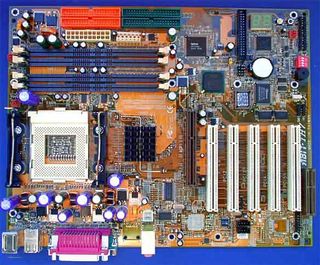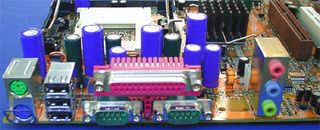Pricey Foundations: 9 Boards For The Pentium 4
Abit TH7: Features Galore

Board revision: 1.0
Bios: TH7ZG (22 March 2001)

After having enjoyed sweeping success due to special overclocking features in its boards, Abit now appears to be resting on its laurels. The company hasn't had too many boards in our tests lately and only trotted out its latest models long after the competition had launched their products.

Port 80 card integrated into the Abit TH7

View of the extra IDE connectors.
The Abit TH7 makes a good showing among the other boards tested, thanks to its interesting features, which run the gamut from the Port 80 card for diagnosing errors, to the highpoint controller for additional IDE drives. The comprehensive "Soft Menu II," which offers a heap of features to overclock your processor, is rather unremarkable though. After all, the Pentium 4 runs stably at higher clock speeds without ratcheting up the voltage, if you increase the FSB rate in steps. The front side bus can be adjusted in rather imprecise increments between 90 MHz and 133 MHz. The CPU core voltage can be finely adjusted from 1.100 volts to 1.850 volts. The CNR slot is an utter waste of space since there aren't any peripheral devices for it. On the other hand, the board's three USB ports, placed one above the other, are a pleasant surprise. High marks are also awarded for the On and Reset switches on the board. The Abit TH7 concludes the performance chapter with average benchmark results, putting it in the mid range.

It ships with a connector for a game controller.
Stay on the Cutting Edge
Join the experts who read Tom's Hardware for the inside track on enthusiast PC tech news — and have for over 25 years. We'll send breaking news and in-depth reviews of CPUs, GPUs, AI, maker hardware and more straight to your inbox.
Current page: Abit TH7: Features Galore
Prev Page Pricey Foundations: Boards With An Intel 850 Chipset, Continued Next Page Aopen AX4T: A Plate Combats Electromagnetic RadiationMost Popular

